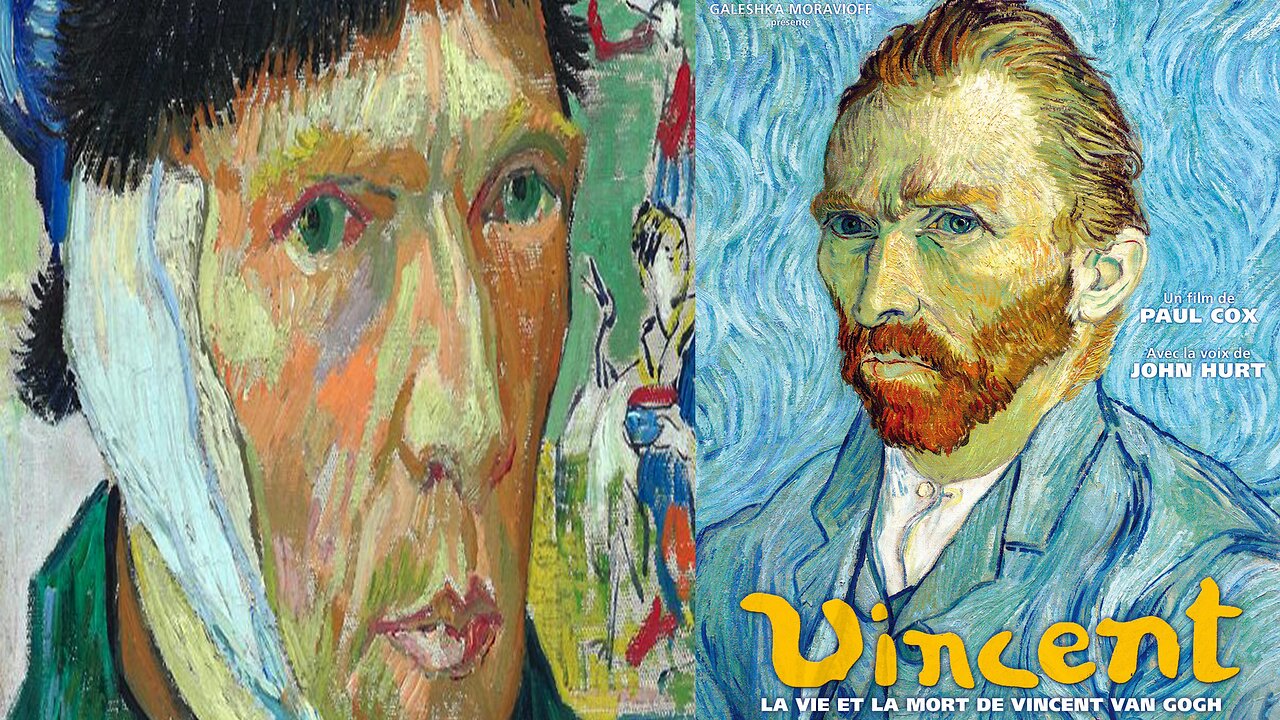Premium Only Content

The Life and Death of Vincent van Gogh
"Vincent: The Life and Death of Vincent van Gogh" (1987)
The visuals for this documentary include still shots of paintings by van Gogh, contrasted with footage showing the actual scenes as they appear to the naked eye. This beautiful montage shows the origins of the art of van Gogh. The narrative is taken directly from letters written by the artist to his brother Theo. Roger Ebert, in his review of this film for the Chicago Sun-Times, said that “Vincent” was “the best film about a painter I have ever seen.”
Starring: John Hurt, Marika Rivera, Gabriella Trsek
Directed by: Paul Cox
"Vincent: The Life and Death of Vincent van Gogh" is a documentary film by Australian director Paul Cox, exploring the last eight years of the artist's life. Cox was attracted to the project because of his personal admiration for Vincent van Gogh:
"I found him such a compassionate, wonderful human being. That attracted me above all. I found him always honest, always real, always doing his utmost, and I related very much to his type of loneliness. It's the loneliness, the dreadful loneliness that I've known all my life. That was still much stronger for me when I tried to become a film-maker - you know, up to 30, 35, I was terribly alone. I was not equipped for the world at all, and, at that level, that is a very similar background to Vincent."
The screen images consist of a wide selection of the paintings and sketches, shown in a chronological sequence, supplemented by shots of the locations he lived in, and a number of dramatized reconstructions of biographical events.
This movie is visually magnificent. The narrative gives us a window into the hopes and fears of this great artist and of his attitude toward his work. Specific paintings and artistic techniques are discussed. The artist tells the viewer, through the letters to his brother what he was trying to achieve. These letters show van Gogh to be a sincere, caring man who was committed to his art and, for most of his life, very lonely. Vincent van Gogh was supported emotionally and financially by his brother Theo.
John Hurt reads the letters of Vincent van Gogh to his brother Theo.
Background:
Vincent van Gogh (1853 – 1890) was one of the great artists of the 19th century. He first tried to be an evangelist, but failed, and turned to painting. He was considered mentally unstable, at one point even cutting off one of his ears. Van Gogh eventually was deemed to have committed suicide.
Van Gogh wanted to express how physical objects, scenes, and people made him feel. Thus, he used vivid colors and broad brush strokes to reveal form and emotion. Van Gogh developed many techniques to express his feelings for people or for the world. “Starry Night” is the painting of a night sky over a village in Southern France. Van Gogh used strong colors and brush strokes so thick that the paint stands out and becomes a three-dimensional addition to the painting. Van Gogh wrote to his brother “The sight of stars makes me dream.”
Sometimes van Gogh would apply paint right from the tube onto the canvas and then put texture into it with his brush, or he might apply paint directly to the canvas with a knife, leaving thick ridges of paint. In his pen and ink drawings, sometimes he used a series of small marks to show us the movement of his subject.
Van Gogh has been classified by art historians as a “Post-Impressionist.” The Impressionists tried to depict scenes naturalistically. The Post-Impressionists painted subjectively, communicating how the scene made them feel. Other Post-Impressionist artists were Paul Cezanne, Paul Gauguin, Henri de Toulouse-Lautrec (see Moulin Rouge) and Georges Seurat.
Van Gogh sold exactly one painting while he was alive and lived off the charity of his brother. His paintings now sell for many millions.
Vincent’s brother Theo, an art dealer living in Paris, supported Vincent throughout his life. While the van Goghs were Dutch, the center of the art world in the late 19th century was Paris. Theo was the manager of a gallery there. Vincent went to Paris and met many of the famous artists of the day.
When van Gogh was living in the South of France another of the great artists of the period, Paul Gauguin, came to live with him for a time. This arrangement ended in discord and disaster and was the occasion for van Gogh’s mutilation of his ear.
---
This video is for educational, historical, and informational purposes only and has not been monetized in any manner whatsoever.
It has been posted as non-monetized and intended to be ad-free.
In Title 17 U.S.C. section 106A-117 of the US Copyright Law and under section 107 of the Copyright Act of 1976, allowance is made for "fair use" for purposes such as criticism, comment, news reporting, teaching, historic preservation, scholarships, education and research.
"Fair use" is a use permitted by copyright statute that might otherwise be infringing.
-
 1:10:51
1:10:51
MetatronGaming
1 day agoBroken Lore Don't Watch Full Game
34.9K1 -
 2:37:56
2:37:56
Side Scrollers Podcast
14 hours agoAsmongold vs DSP - HAPPENING NOW
9.09K8 -
 8:38
8:38
MattMorseTV
13 hours ago $9.83 earnedThe Operation is NOW UNDERWAY.
12.2K38 -
 1:12:29
1:12:29
PandaSub2000
1 day agoSonic Galactic | GAME ON...ly! (Edited Replay)
3.68K3 -
 19:15
19:15
Nikko Ortiz
1 day agoOstrich Gets A Taste For Human Blood
78.5K19 -
 24:26
24:26
GritsGG
11 hours agoGiga-Big Duo Game w/ Mr. Poff! Most Winning Duo EVER!
4.14K -
 21:54
21:54
The Pascal Show
10 hours ago $1.66 earned$1.5 MILLION HIT?! Candace Owens Drops More Shocking Info On Her France Hit Plot THIS IS INSANE!
6.16K6 -
 LIVE
LIVE
Lofi Girl
3 years agolofi hip hop radio 📚 - beats to relax/study to
191 watching -
 1:29:13
1:29:13
ThisIsDeLaCruz
10 hours ago $3.95 earnedRunning Sound for 1.6 MILLION PEOPLE!!! Madonna In Rio
14.5K2 -
 2:18:52
2:18:52
FreshandFit
14 hours agoBlack Girl Gets Triggered After We Said THIS....
202K56